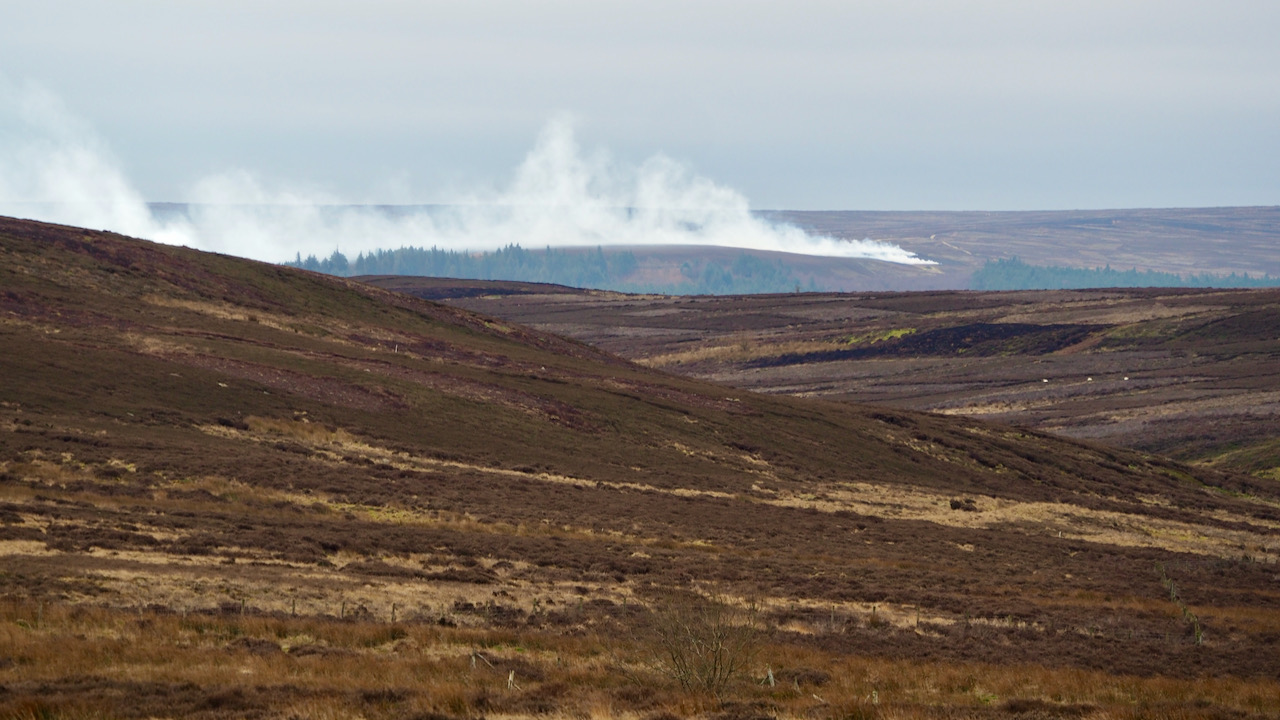I am always saddened when I see those great plumes of smoke drifting across the skyline. It’s a stark reminder, according to the State of Nature Report 2023, that the UK has earned itself a reputation as “one of the most nature-depleted countries on Earth“, with biodiversity taking a significant hit1State of Nature 2023, the State of Nature partnership, Available at: https://stateofnature.org.uk/wp-content/uploads/2023/09/TP25999-State-of-Nature-main-report_2023_FULL-DOC-v12.pdf .
A good three-quarters of our moorlands are either damaged or degraded, courtesy of a medley of pressures like acidification from nitrogen deposition, overgrazing, drainage, planting commercial timber forests, and, of course, burning. Many of those specialised heathland and bog plants are in decline.
Now, the burning of heather on the moors on this day isn’t exactly against the law. The season doesn’t wrap up until April 15th2The Heather and Grass Burning Code. 2007. <https://gfmc.online/programmes/natcon/UK-DEFRA–Heather-Grass-Burning-Code-2007.pdf> . Yet, this very morning, I spotted lapwings, curlews, and geese, along with the ever-present red grouse, the very bird driving this burning. Haven’t these birds kicked off their courtship rituals yet?
Even though only the highest of the North York Moors are designated as ‘blanket bog’, our entire expanse of moorlands is still essentially peat, storing a large amount of carbon. Any burning will free up this carbon into the atmosphere. Rotational burning is purportedly carried out to enhance conditions for raising grouse for the shoot. The government tried to rein in this burning with the Heather and Grass etc. Burning (England) Regulations 2021, but organisations like the Wildlife and Countryside Link argue it’s weak, with loopholes galore. They’re adamant that all upland peatlands should be off-limits to burning because, well, it releases carbon and wrecks the ecosystem3The Heather and Grass Etc. Burning (England) Regulations 2021: A Start, Not a Solution Link Policy Briefing Background. [n.d.]. <https://www.wcl.org.uk/docs/The%20Heather%20and%20Grass%20etc.%20Burning%20(England)%20Regulations%202021%20-%20Link%20Policy%20Briefing.pdf> [accessed 13 March 2024].
One argument is that these burns are ‘cool,’ meaning only the heather is burnt, not the peat. But even with this precision, burning still damages the peat habitat and lets loose a good deal of carbon into the atmosphere. The fire not only directly releases emissions but also dries out the peat, causing it to degrade and release even more carbon. They say it takes something like ten years for burnt peatlands to return to their natural water levels. Burning every decade significantly reduces carbon storage compared to unburned patches.
Another yarn spun is that burning creates an important habitat for curlews and other waders. But killing predators and birds of prey also helps in keeping this habitat conducive to sustaining an unusually large population of red grouse for sole purpose of hunting. There are better ways to help to wading birds, like restoring their natural habitat and letting mosses flourish.
Wildfires are another worry, with land managers arguing ‘cool’ burns are the only way to prevent wildfires. However, land managers conduct controlled burns on heather to encourage its rejuvenation, prompting denser growth and a greater fire risk. But let’s face it, a heather monoculture isn’t natural for these moors. Left to its own devices, these lands would be diverse with boggy havens. Burning just traps us in a cycle of, you guessed it, more burning.
If we genuinely want to reduce wildfire risks, we’ve got to return the moors to their natural boggy state. That means raising the water levels and replanting peat moss. Bogs are supposed to be wet and not exactly fire-friendly. We could even remove some heather or mow down firebreaks if need be.
To shield nature and tackle climate change, we ought to ban all burning and work towards restoring these moorlands to their wet, boggy natural state. Climate change and biodiversity loss are only going to worsen matters in these areas. By restoring them now, we can bolster their resilience against these threats in the long term.
- 1State of Nature 2023, the State of Nature partnership, Available at: https://stateofnature.org.uk/wp-content/uploads/2023/09/TP25999-State-of-Nature-main-report_2023_FULL-DOC-v12.pdf
- 2The Heather and Grass Burning Code. 2007. <https://gfmc.online/programmes/natcon/UK-DEFRA–Heather-Grass-Burning-Code-2007.pdf>
- 3The Heather and Grass Etc. Burning (England) Regulations 2021: A Start, Not a Solution Link Policy Briefing Background. [n.d.]. <https://www.wcl.org.uk/docs/The%20Heather%20and%20Grass%20etc.%20Burning%20(England)%20Regulations%202021%20-%20Link%20Policy%20Briefing.pdf> [accessed 13 March 2024]

Leave a Reply